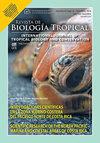High frequency of larval abnormalities of the toad Rhinella arenarum (Anura: Bufonidae) in an Argentinian agroecosystem
IF 0.6
4区 生物学
Q4 BIOLOGY
引用次数: 0
Abstract
Introduction: The frequent use of pesticides is currently considered a cause of environmental pollution due to the high rate of entry of these substances into agroecosystems. This constitutes a risk for the species that inhabit these ecosystems, in particular anurans whose characteristics make them prone to exposure to and interaction with environmental pollutants. Objective: To report the occurrence of abnormalities in larvae of the common toad Rhinella arenarum inhabiting ponds surrounded by agroecosystems. Methods: In two consecutive springs (2015 and 2016), reproductive events of common toads were monitored in temporary pond systems in agricultural and non-agricultural areas, located near the city of La Plata (Buenos Aires, Argentina). The physicochemical parameters of the ponds were measured, and the stage of each reproductive event was recorded, such as the numbers of adult toads, amplexus and clutches. In the laboratory, the larvae were measured and photographed, their stage of development was recorded, and their morphology was examined under a stereomicroscope. Representative samples (normal and abnormal) from each pond studied were processed for histopathological analysis. Results: In the field studies carried out on a population of R. arenarum collected in an agroecosystem, a lower number of reproductive adults and clutches were observed in relation to the population of a non-agricultural pond. A total of 1 910 larvae were collected: 529 and 1 381 larvae from ponds located in non-agricultural and agricultural areas, respectively. Larvae from the agroecosystem showed two types of abnormalities: severe tail flexure and abdominal bloating. In addition, five degrees of severity could be determined in relation to abdominal bloating. Conclusions: This work reports the high frequency and severity of abnormalities observed in the early stages of R. arenarum larvae living within an agroecosystem, providing evidence of the negative impact that agricultural activities cause on aquatic ecosystems surrounded by farming areas.阿根廷农业生态系统中沙蟾蜍(无尾目:蟾科)幼虫异常的高频率
引言:农药的频繁使用目前被认为是环境污染的一个原因,因为这些物质进入农业生态系统的比率很高。这对栖息在这些生态系统中的物种构成了风险,尤其是无尾类,它们的特征使它们容易暴露于环境污染物并与环境污染物相互作用。目的:报道生活在农业生态系统周围池塘中的普通蟾蜍犀幼虫的异常情况。方法:在连续两个春季(2015年和2016年),在拉普拉塔市(阿根廷布宜诺斯艾利斯)附近的农业和非农业地区的临时池塘系统中监测普通蟾蜍的繁殖事件。测量池塘的物理化学参数,并记录每次繁殖事件的阶段,如成年蟾蜍、蟾蜍和蟾蜍的数量。在实验室中,对幼虫进行了测量和拍照,记录了它们的发育阶段,并在立体显微镜下检查了它们的形态。对所研究的每个池塘的代表性样本(正常和异常)进行组织病理学分析。结果:在对农业生态系统中采集的沙蚕种群进行的实地研究中,观察到与非农业池塘的种群相比,繁殖成虫和离合器的数量较低。共采集到910只幼虫:529只和1381只分别来自非农业和农业池塘。农业生态系统的幼虫表现出两种类型的异常:严重的尾部弯曲和腹部肿胀。此外,可以确定与腹部腹胀有关的五种严重程度。结论:这项工作报告了在农业生态系统中生活的沙蚕幼虫早期观察到的高频率和严重性异常,为农业活动对农业区周围的水生生态系统造成的负面影响提供了证据。
本文章由计算机程序翻译,如有差异,请以英文原文为准。
求助全文
约1分钟内获得全文
求助全文
来源期刊

Revista De Biologia Tropical
生物-生物学
CiteScore
1.80
自引率
0.00%
发文量
23
审稿时长
4-8 weeks
期刊介绍:
The Revista de Biología Tropical / International Journal of Tropical Biology and Conservation is a mainstream scientific journal published since 1953 and covered by Web of Science; Science Citation Index; Current Contents; Google Scholar; Scopus, SciELO and nearly 50 additional indices.
A double blind system guarantees you a fair evaluation, and our world class editorial and scientific boards provides a first decision in three working days. The journal is Full Open Access and is widely read where your article can have the highest real impact.
Since its beginning in 1953, the Revista follows these principles: objective and independent evaluation of all manuscripts; transparency in all processes; ethical use of procedures, data, specimens and subjects; fair treatment of all parties; and absolute predominance of scientific rigor over any other aspect.
 求助内容:
求助内容: 应助结果提醒方式:
应助结果提醒方式:


